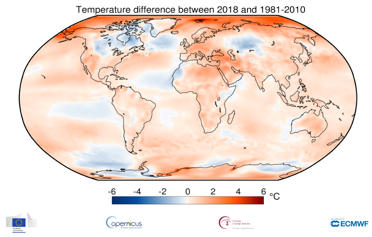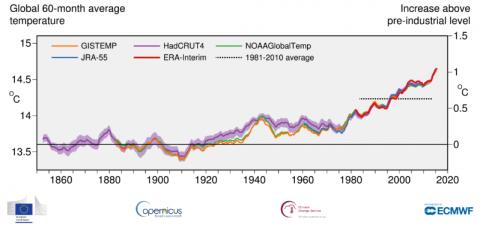Copernicus: last four years have been the warmest on record – and CO2 continues to rise
j F Y in In Evidenza
Data released by the Copernicus Climate Change Service (C3S) show that 2018 was the fourth in a series of exceptionally warm years and together with the Copernicus Atmosphere Monitoring Service (CAMS), C3S reports that atmospheric CO2 concentrations have continued to rise.
C3S and CAMS are services of the European Union’s Earth observation programme Copernicus and are implemented by ECMWF. Their data provide the first complete, global picture of 2018 temperatures and CO2 levels. The results are in line with previous projections from WMO and the Global Carbon Project (GCP) for 2018. The temperature dataset of the Copernicus Climate Change Service shows that the global average surface air temperature was 14.7°C, 0.2°C lower than in 2016, the warmest year on record. The data reveal that:
- The last four years have been the warmest four on record, with 2018 being the fourth warmest, not far short of the temperature of the third warmest year 2015.
- 2018 was more than 0.4°C warmer than the 1981-2010 average.
- The average temperature of the last 5 years was 1.1°C higher than the pre-industrial average (as defined by the IPCC).
- Europe saw annual temperatures less than 0.1°C below those of the two warmest years on record, 2014 and 2015.
Furthermore, according to satellite measurements of global atmospheric CO2 concentrations:
- CO2 continued to rise in 2018 and increased by 2.5 +/- 0.8 ppm/year.
“The Copernicus Climate Change Service provides quality assured data of climate indicators like surface temperature, sea-ice cover and hydrological variables like precipitation”, says Jean-Noël Thépaut, Head of the Copernicus Climate Change Service (C3S). “In 2018, we have again seen a very warm year, the fourth warmest on record. Dramatic climatic events like the warm and dry summer in large parts of Europe or the increasing temperature around the Arctic regions are alarming signs to all of us. Only by combining our efforts, can we make a difference and preserve our planet for future generations.”
C3S provides an early picture of 2018 global temperatures
The C3S temperature data for 2018 is the first complete set to be published including annual anomalies and globally averaged fields. C3S can provide the global picture so rapidly because it is an operational programme, processing millions of land, marine, airborne and satellite observations daily. A mathematical model is used to bring all these observations together, in a similar way to what is done in weather forecasting. The benefit to users of the data is that they have an accurate estimate of temperatures at any time or place they choose – even in sparsely-observed areas like the polar regions.
The Copernicus C3S data show that 2018 surface temperatures were more than 0.4°C higher than the long-term average recorded over the period 1981-2010. The most pronounced warming compared to the long-term average occurred in the Arctic, in particular in and north of the Bering Strait between USA and Russia and around the Svalbard archipelago. Most land areas were warmer than average, especially Europe, the Middle East and the western USA. In contrast, the northeast of north America and some central areas of Russia and central Asia experienced below average annual temperatures.
Apart from a relatively cold February and March, Europe saw above average temperatures during all months of the year. Starting at the end of spring and continuing well into autumn, and in some places even winter, northern and central Europe experienced weather conditions that were persistently warmer and drier than average.
Air temperature at a height of two metres for 2018, shown relative to its 1981–2010 average.
Source: Copernicus Climate Change Service, ECMWF
Running 60-month averages of global air temperature at a height of two metres (left-hand axis) and estimated change since the pre-industrial period (right-hand axis) according to different datasets: ERA-Interim (Copernicus Climate Change Service, ECMWF); GISTEMP (NASA); HadCRUT4 (Met Office Hadley Centre), NOAAGlobalTemp (NOAA); and JRA-55 (JMA).
https://climate.copernicus.eu/last-four-years-have-been-warmest-record-and-co2-continues-rise








